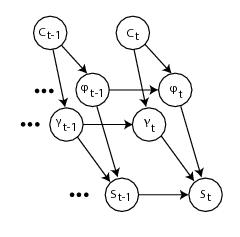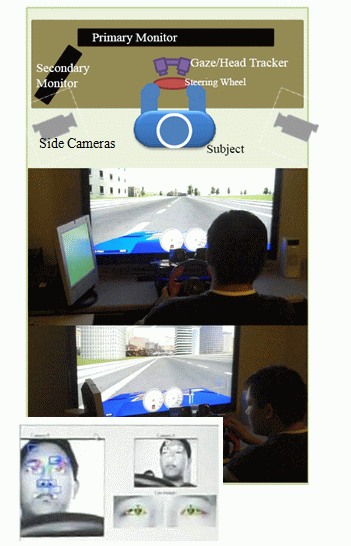Past and Current Projects
Sequential Dependencies in Choice and Judgment
When individuals make a series of judgments they are influenced by their recent experience. For example, if you are asked to rate movies on a 1-10 scale, the rating you'll give to a particular movie will depend on how much you liked the previous movie you rated. These sequential dependencies arise in all aspects of cognition, whether you are making evaluative judgements or simply perceiving the world around you. In the simplest task exhibiting sequential dependencies, participants are shown one of two stimuli, say a dot on the left or a dot on the right of the screen, and are asked to press a button either on the left or the right corresponding to the dot location. Response latency and error rate depends on the most recent half dozen trials.

Reaction time as a function of the prevoius four trials: human data (blue) and DBM2 (red)
We have built a model, the DBM2, that predicts the detailed pattern of response latencies and error rates. The model has two distinct learning mechanisms, one that learns statistics of the response (left or right) and one that learns statistics of the sequence (repetitions or alternations). We've conducted a neurophysiological experiment to show distinct activation patterns in the brain corresponding to these two mechanisms. We've also shown that a relatively sophisticated learning takes place with each experience: error correction updates with a power-function decay.

The architecture of DBM2
 It would be an academic exercise of limited value if these sequential
dependencies occurred only in the simplest laboratory tasks. However, in
another line of research, we are exploring sequential effects in more
naturalistic tasks, including driving (the pattern of braking and accelerating)
and reaching (with forces applied in random directions from trial to trial).
We find similar sequential effects in these naturalistic, more complex tasks.
In fact, the effects in driving are large enough to be of consequence:
reaction times are slowed by 100 milliseconds in some sequential contexts,
which corresponds to an increased braking distance of 10 feet when traveling
at 65 miles per hour. One long term goal is to use sequential effects to
predict when drivers will be slower to respond and for the automobile to
anticipate the drivers' behavior.
It would be an academic exercise of limited value if these sequential
dependencies occurred only in the simplest laboratory tasks. However, in
another line of research, we are exploring sequential effects in more
naturalistic tasks, including driving (the pattern of braking and accelerating)
and reaching (with forces applied in random directions from trial to trial).
We find similar sequential effects in these naturalistic, more complex tasks.
In fact, the effects in driving are large enough to be of consequence:
reaction times are slowed by 100 milliseconds in some sequential contexts,
which corresponds to an increased braking distance of 10 feet when traveling
at 65 miles per hour. One long term goal is to use sequential effects to
predict when drivers will be slower to respond and for the automobile to
anticipate the drivers' behavior.
Students
Anup Doshi (Electrical Engineering, UCSD)
Cuong Tran (Electrical Engienering, UCSD)
Matt Wilder (Computer Science, Colorado)
Collaborators
Alaa Ahmed (Kinesiology, Colorado)
Tim Curran (Psychology, Colorado)
Matt Jones (Psychology, Colorado)
Mohan Trivedi (Electrical Engineering, UCSD)
